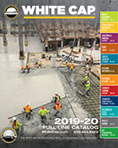The Importance Of Hearing Protection
Hearing loss can cost contractors
The Center for the Protection of Workers Rights recently launched a promotional program warning 2/3 of workers in the concrete and masonry industry are exposed to noise levels exceeding the NIOSH recommended exposure limit. The effect of this unhealthy exposure is not often immediately recognized. But employers who fail to provide the proper protection will eventually pay in two ways. While it’s impossible to put a jobsite cost on hearing loss, OSHA estimates employers spend more than $240 million annually on workers’ compensation for hearing loss disability.
But there is real clear contractor cost to hearing loss. U.S. businesses paid more than $1.5 million in penalties for not protecting workers from noise. Failure to comply with OHSA’s General Safety and Health Provisions (1926.20) was the 9th most common citation in 2017. Hearing protection is included in this category.
Protecting workers from exposure to excessive noise is more than providing personal protection equipment. Concrete contractors must comply with two OSHA standards. 1926.101(a) states:
- Contractors must make every effort to reduce noise exposure on the job site. And should the engineering and administrative efforts fall short,
- Contractors must provide effective personal hearing protection.
OSHA offers contractors insights on minimizing jobsite worker exposure. They define this with a three-step approach to reducing worker noise exposure: Reduce it, Move It, and Block It.
Reduce It
The most effect way to reduce noise on a construction site starts by selecting, updating, and replacing older equipment and tools. Manufacturers have made great strides in recent years to lower the sound emitted from equipment including hand tools and power generators. One key industry improvement on noise exposure, especially in interior work such as slabs, has been the introduction of electrical and battery powered tools and equipment.
Move It
Controlling noise exposure through distance is often an effective, yet simple and inexpensive administrative control. Specifically, for every doubling of the distance between the source of noise and the worker, the noise is decreased by 6 dBA. Contractors should consider moving either the noise source or nearby workers.
Contractors can also move exposure with administrative controls. Superintendents can enable changes in the workplace by scheduling contractors when they are least likely to be exposed to high levels of noise (such as when heavy machinery is being operated) or performing concrete breakouts when fewer workers are on the jobsite.
Block It
Blocking the noise source is the third step of noise protection. Some contractors place sound walls or curtains between the noise source and employee. For continuous noise sources, such as power generators, contractors can enclose or isolate the equipment. On congested jobsites, consider providing quiet areas where workers can gain relief from hazardous noise sources.
Personal Hearing Protection
When these jobsite controls fail to effectively reduce noise exposure, contractors must consider hearing protection devices (HPDs). Personal protection equipment is considered the last option for controlling noise exposures. HPDs are generally used during the time it takes to implement engineering or administrative controls, or when such controls are not feasible.
Unless great care is taken in establishing a hearing conservation program, workers will often receive very little benefit from HPDs. The best hearing protector, when fitted correctly, is one that is accepted by the worker and worn properly. If the worker exposure is above 85 dBA (8-hour TWA), hearing protection must be made available, along with the other requirements in the hearing protection program.
EarPlugs
 Earplugs come in a variety of sizes, shapes, and materials and can be reusable and/or disposable. Earplugs are designed to occlude the ear canal when worn. Many earplugs can offer protection against the harmful effects of impulse noise. Other earplug styles are designed specifically to reduce this type of noise. Contractors must take care to select earplugs that are spec’d for the type of noise in their environment.
Earplugs come in a variety of sizes, shapes, and materials and can be reusable and/or disposable. Earplugs are designed to occlude the ear canal when worn. Many earplugs can offer protection against the harmful effects of impulse noise. Other earplug styles are designed specifically to reduce this type of noise. Contractors must take care to select earplugs that are spec’d for the type of noise in their environment.
Earmuffs
 Earmuffs are another type of hearing protector. Earmuffs are designed to cover the external ear and thus reduce the amount of sound reaching the inner ear. Care must be taken to ensure that the seal of the earmuff is not broken by safety glasses, facial hair, respirators, or other equipment. Even a very small leak in the seal can destroy the effectiveness of the earmuff. Earmuffs should be chosen based on the frequency that needs to be reduced.
Earmuffs are another type of hearing protector. Earmuffs are designed to cover the external ear and thus reduce the amount of sound reaching the inner ear. Care must be taken to ensure that the seal of the earmuff is not broken by safety glasses, facial hair, respirators, or other equipment. Even a very small leak in the seal can destroy the effectiveness of the earmuff. Earmuffs should be chosen based on the frequency that needs to be reduced.
Hearing bands
 Hearing bands are a third type of HPD. They are similar to earplugs, but with a stiff band that connects the portions that insert into a worker’s ears. The band typically wraps around the back of the wearer’s neck, though variations are available. Hearing bands may not provide the same noise attenuation as properly fitting earplugs, as the portions that fit into the ears are stationary and cannot be twisted into place like earplugs.
Hearing bands are a third type of HPD. They are similar to earplugs, but with a stiff band that connects the portions that insert into a worker’s ears. The band typically wraps around the back of the wearer’s neck, though variations are available. Hearing bands may not provide the same noise attenuation as properly fitting earplugs, as the portions that fit into the ears are stationary and cannot be twisted into place like earplugs.
Earplugs, earmuffs, or hearing bands alone might not provide sufficient protection from significantly high noise levels. For these severe conditions, workers should wear double hearing protection (earmuffs with earplugs).

![]()
Check out these links for more detailed information about hearing loss and prevention.
https://www.osha.gov/SLTC/noisehearingconservation/
https://www.osha.gov/news/newsreleases/trade/08022016




